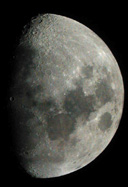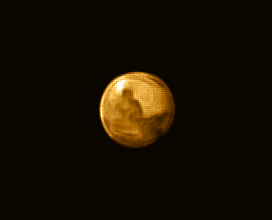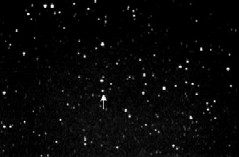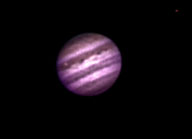Solar System
December 14, 2006
As I was driving the last mile of my commute this evening I noticed the northeast sky was unusually bright. After parking the car I gave the sky a closer
look and realized a bright display of Northern Lights was underway. I rushed inside the house, grabbed my camera and tripod and made it to the
front yard to catch a few photos. The photos here were taken over a period of 2 hours. I would be understating the event to say it was
a spectacular show! Below I have arranged the photos close to the order that they were taken. To get a perspective on how the event
evolved, view the slides left to right then down the page. I have labeled the slides according to terminology found in the book The Auroras
by Jim Henderson and John MacNicol. The book appears to be out of print but if you can find a copy I recommend it. The auroral display
this evening grew in intensity as the evening progressed. There were various phenomena occuring across the northwest-north-northeast skies.
The most intense activity occurred in the northeast and spread laterally to the north. At the peak activity, bright auroral rays spiked
down low to the northeast horizon, then folded like a curtain. A bright patch could be seen traveling laterally to the west like a wave
hitting a shoreline. It was very impressive to watch.
Auroral Rays began early in the evening. The atmosphere was clear when the first rays appeared in the northeast. Note the
building excitation of the atmosphere and a thickening of intervening clouds. I don't know if the thickening clouds were related to the
auroras but oddly enough the northern horizon was clear as welll as the sky directly overhead and to the south. Much of the orange-hued illumination of the
clouds was due to ground lighting of the town to the north. The purple, red, and greenish hue is excitation due to the auroras.
In the photo labeled Auroral Patch you may notice the constellation of Taurus and Pleiades Cluster rising in the background. In later
northward facing images titled Bright Ray, you may see the bowl of the Big Dipper.
For more information on Auroras and Solar events see Spaceweather.Com
I assembled a couple still frames into a crude animation. Be forewarned, the file is 700KB.
Click here to view animation...
December 10, 2002
 Believe it or not, this wonderful image of the moon was taken with an Olympus Camedia D-360L (quick shot) digital camera. Minus the digital
camera, this is a somewhat low-tech lunar image. If you have a telescope, digital camera and a willingness to experiment you may have the
ingredients to produce a similar image of your own. Using a low powered eyepiece, focus the telescope on the moon. Having a motorized clock drive on your
telescope helps considerably but is not required. Without the drive you may reach your frustration point quicker but keep at it. Now, my
D-360L digital camera has a "sports mode" that takes images repetitively at 1/30 of a second while you hold the shutter button down. It
also has an video panel on the back of the camera showing the view as the camera sees it. Here's the trick: using sports mode and the
video panel you can hold the camera to the eyepiece and snap away photo after photo. This is a crude form of a webcam. The trick is to
be able to position the camera lens over the eyepiece and hold it there long enough to grab a few frames. The telescope acts as a
projection unit for the camera. For lunar photos you'll want faster shutter speeds to avoid overexposing the bright lunar surface. Don't
bother with auto-exposure as the camera will confuse the dark background sky with the moon and almost always overexpose the moon. With
my camera the sports mode uses a fixed 1/30 of a second exposure which happened to work well. After transferring your digital images to
your computer you are likely to find all sorts of dark frames mixed with odd looking sections of the moon. Occassionally you might find
a well focused and evenly exposed image of a crater. If all are misses...go try again! You never know how a digital camera will perform.
If you are patient you may be rewarded with an image to enjoy for a long, long time.
Believe it or not, this wonderful image of the moon was taken with an Olympus Camedia D-360L (quick shot) digital camera. Minus the digital
camera, this is a somewhat low-tech lunar image. If you have a telescope, digital camera and a willingness to experiment you may have the
ingredients to produce a similar image of your own. Using a low powered eyepiece, focus the telescope on the moon. Having a motorized clock drive on your
telescope helps considerably but is not required. Without the drive you may reach your frustration point quicker but keep at it. Now, my
D-360L digital camera has a "sports mode" that takes images repetitively at 1/30 of a second while you hold the shutter button down. It
also has an video panel on the back of the camera showing the view as the camera sees it. Here's the trick: using sports mode and the
video panel you can hold the camera to the eyepiece and snap away photo after photo. This is a crude form of a webcam. The trick is to
be able to position the camera lens over the eyepiece and hold it there long enough to grab a few frames. The telescope acts as a
projection unit for the camera. For lunar photos you'll want faster shutter speeds to avoid overexposing the bright lunar surface. Don't
bother with auto-exposure as the camera will confuse the dark background sky with the moon and almost always overexpose the moon. With
my camera the sports mode uses a fixed 1/30 of a second exposure which happened to work well. After transferring your digital images to
your computer you are likely to find all sorts of dark frames mixed with odd looking sections of the moon. Occassionally you might find
a well focused and evenly exposed image of a crater. If all are misses...go try again! You never know how a digital camera will perform.
If you are patient you may be rewarded with an image to enjoy for a long, long time.
April 1, 2006
 The day was solid overcast skies. The 2006 lunar occultation of Messier 45 all but history when a stiff wind blew in.
The sky began to clear. The bright outline of the moon appeared on the underside of the clouds.
Then there it was - the moon! I rushed inside to grab my camera and setup the tripod. As luck would have it,
a friend had loaned me a 300mm zoom lens to try out. The 300mm nicely framed the crescent moon
brushing past the open star cluster Messier 45 (more commonly known as the Pleiades). Unfortunately
the final stages of the occultation (i.e., one relatively close celestial object passing in front of another
more distant object temporarily blocking its light) had ended perhaps 30 minutes earlier. Within 10 minutes the clouds
reclaimed the scene and that was it for the lunar occultation observing from Prairiehill Farm.
The day was solid overcast skies. The 2006 lunar occultation of Messier 45 all but history when a stiff wind blew in.
The sky began to clear. The bright outline of the moon appeared on the underside of the clouds.
Then there it was - the moon! I rushed inside to grab my camera and setup the tripod. As luck would have it,
a friend had loaned me a 300mm zoom lens to try out. The 300mm nicely framed the crescent moon
brushing past the open star cluster Messier 45 (more commonly known as the Pleiades). Unfortunately
the final stages of the occultation (i.e., one relatively close celestial object passing in front of another
more distant object temporarily blocking its light) had ended perhaps 30 minutes earlier. Within 10 minutes the clouds
reclaimed the scene and that was it for the lunar occultation observing from Prairiehill Farm.
February 20, 2006
Planetary imaging works best when a large number of images can be taken in rapid succession. The goal is to be imaging during those intermittent
periods of steady atmosphere and thermal currents. Viewing a planet through an eyepiece typically shows a fuzzy scene with occassional
moments of stunning clarity. Planetary imagers try to maximize their chances of capturing a clear image by rapidly recording as many images
as possible. CCD cameras, camrecorders, webcams, etc. can all be used for planetary imaging. I've tried a number of techniques over the years.
I first attempted to image Saturn using my CCD camera in March of 2005. The effort to take planetary CCD images is made easy by the camera control software;
however, the subsequent image processing steps are pretty involved. The CCD camera outputs hundreds of separate files that must be aligned
and combined to produce the final image. The first image shows the results of many, many processing steps.


On February 8, 2006 I tried again
using my ToUCam Pro II webcam. Taking images with the webcam is easier than the CCD camera. One output AVI file is generated
per recording. Each AVI file contains a large number of color images. Using the shareware program Registax, the AVI files are scanned for the
highest quality (i.e., "..those stunning moments of clarity") then aligned and combined. Once combined, Registax facilitates additional sharpening and histogram adjustments.
My results are shown in the second image. Of the two, I like the CCD image better but the webcam image is a first attempt! With
a few extra steps I think the webcam will surpass the CCD camera results and do so with much less image
processing time. Stay tuned for future posts.
15-27 October 2005

 With Mars nearing it's closest approach to Earth for many years to come, I tried to capture the event with webcam imaging. I added a ToUCam Pro II webcam to my
toolbox and had been learning the video imaging techniques during the preceeding weeks. Here I've included two images from my early trials. The first was
taken October 15th near midnight. The second on October 27-28th between midnight and 1 am CST. I used two program to control the webcam image capture: K3CCDTools
and WcCtrl. The AVI files were processed K3CCDTools, Registax Version 3 and Photoshop Elements 2 with the Hidden Power Tools plug-in. As astronomy happenings go I
captured a spectacular event on Mars. Some reports indicated an outgassing event and others an extremely bright dust storm. I believe the dust storm explanation
carried the most weight. In the 20051028 image, note the bright area in the upperleft of the planet's disk. In the 20051015 image you will note the remnant of the Mars
frozen polar cap. I need to continue balancing the colors of these images but that's part of the fun. I will research and add more details about the surface features
in these images in the future.
Enjoy!
With Mars nearing it's closest approach to Earth for many years to come, I tried to capture the event with webcam imaging. I added a ToUCam Pro II webcam to my
toolbox and had been learning the video imaging techniques during the preceeding weeks. Here I've included two images from my early trials. The first was
taken October 15th near midnight. The second on October 27-28th between midnight and 1 am CST. I used two program to control the webcam image capture: K3CCDTools
and WcCtrl. The AVI files were processed K3CCDTools, Registax Version 3 and Photoshop Elements 2 with the Hidden Power Tools plug-in. As astronomy happenings go I
captured a spectacular event on Mars. Some reports indicated an outgassing event and others an extremely bright dust storm. I believe the dust storm explanation
carried the most weight. In the 20051028 image, note the bright area in the upperleft of the planet's disk. In the 20051015 image you will note the remnant of the Mars
frozen polar cap. I need to continue balancing the colors of these images but that's part of the fun. I will research and add more details about the surface features
in these images in the future.
Enjoy!
6-7 November 2005
I heard various press reports regarding the new Trans-Plutonian objects but the interesting news came through the Cedar Rapids
Amateur Astronomers Yahoo Group "cedar-astronomers". There minor planet enthusiasts posted detailed ephemeris reports that sparked
my interest in trying to locate and image these objects. Ephemeris reports contain orbital parameters that can be input to astronomical sky
charting programs such as TheSky Version 6. I will add more detail to this section when time permits. In the short term I will
briefly describe the images here of one of the new objects 2003 EL61. For a more in depth discussion of EL61 itself see the CalTech posting at 2003 EL61.
 The first solid imaging happened on August 6th. The weather was nearly perfect however, EL61's low position in the western sky left only
a short window for imaging. Once twilight passed there was roughly 70 minutes of time to gather images before EL61 dipped too
low in the west. I setup the 10" LX200 with the SBIG AO-7 Adaptive Optics unit attached to the SBIG ST-7XE CCD camera. Although the SBIG CFW8
color filter wheel was docked to the ST-7XE only the luminance filter was used. On 8/6 I took 17 2 minute exposures and digitally combined them to
produce the first image.
The first solid imaging happened on August 6th. The weather was nearly perfect however, EL61's low position in the western sky left only
a short window for imaging. Once twilight passed there was roughly 70 minutes of time to gather images before EL61 dipped too
low in the west. I setup the 10" LX200 with the SBIG AO-7 Adaptive Optics unit attached to the SBIG ST-7XE CCD camera. Although the SBIG CFW8
color filter wheel was docked to the ST-7XE only the luminance filter was used. On 8/6 I took 17 2 minute exposures and digitally combined them to
produce the first image.
 I generated the second image the following evening of 8/7. This night weather conditions appeared very good at the zenith but a low haze
existed to the west. Coupled with this a sliver of moon which just emerged from between the Earth and Sun. By the time it was dark enough
to image the moon had slipped below the horizon. I also had trouble with fog on the imager itself. The resulting image was very noisey and difficult to
digitally process but it revealed the target star field. The second image is a combination of 14 2 minute luminance images.
I generated the second image the following evening of 8/7. This night weather conditions appeared very good at the zenith but a low haze
existed to the west. Coupled with this a sliver of moon which just emerged from between the Earth and Sun. By the time it was dark enough
to image the moon had slipped below the horizon. I also had trouble with fog on the imager itself. The resulting image was very noisey and difficult to
digitally process but it revealed the target star field. The second image is a combination of 14 2 minute luminance images.
 The third image is a zoom of the lower right quadrant of the 8/6 image. It shows what appears to be EL61 as two objects.
EL61 is in fact a binary object. I will have to return to image EL61 in a few months when it is in a more favorable location
of the sky for extended exposures. I'd like to use high resolution images to determine whether or not my equipment is resolving
the pair of objects. Right now I believe it is an intriguing possibility and will pursue it further.
The third image is a zoom of the lower right quadrant of the 8/6 image. It shows what appears to be EL61 as two objects.
EL61 is in fact a binary object. I will have to return to image EL61 in a few months when it is in a more favorable location
of the sky for extended exposures. I'd like to use high resolution images to determine whether or not my equipment is resolving
the pair of objects. Right now I believe it is an intriguing possibility and will pursue it further.
Finally, the last link takes you to an animation which cycles between the 8/6 and 8/7 images. You will note the difference in the background noise but
the images have been aligned on the brightest stars. Focus your attention in the lower right quadrant and you will see EL61's location changing with
respect to the distant stars. This technique is referred to as "blink comparison".
Click to view two day blink comparison (127 KB)
If you have any questions or comments my e-mail address is: gdclinch at wildblue dot net
(you'll have to translate).
Thursday, 31 July
Stunning amateur photographs of the solar system’s planets have been common in magazines and
Internet sites but Pluto photographs are comparatively rare. Many amateurs like myself probably don't
realize Pluto may be within reach of their telescopes. My challenge was to see what it would take to
image Pluto with my amateur astronomy tools.

First a little background on my Pluto challenge. Long ago as a young boy I read the story of Pluto’s discovery in a book titled “The Search for Planet X”. I don’t remember the author but I’ve always remembered the tale of Clyde Tombaugh’s tireless search for the suspected “Planet X”. It wasn’t until Tombaugh’s discovery on January 23, 1930 that our view of the solar system grew from eight to nine planets. With a diameter of 1454 miles Pluto is a bit smaller than the Earth’s moon. All planets with the exception of Pluto orbit the Sun in a common plane known as the “plane of the ecliptic”. The plane of Pluto’s orbit is inclined 17 degrees to the plane of the ecliptic. Pluto is approximately 3.6 billion miles from the Sun (that’s 5.4 hours travel time at the speed of light!). At that distance Pluto is pretty darn cold at –390 degrees Fahrenheit (F). For comparison dry ice is -109 degrees F and liquid nitrogen is -321 degrees F. Pluto’s dim light cannot be seen with the human eye. It has one moon called Charon. Somehow astronomers determined the length of a Plutonian day to be 6.4 Earth days. Pluto’s orbit around the sun takes 248.5 Earth years. These days Pluto traverses an area of the night sky that it hasn’t visited since 20 years prior to signing of the United States Declaration of Independence! NASA has plans to send a science mission to Pluto. If the launch occurs on schedule in 2006, we may know more about Pluto in 2015.































